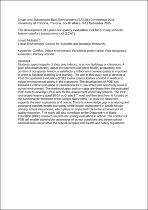 ResearchSpace
ResearchSpace
The development of a post occupancy evaluation tool for primary schools: learner comfort assessment tool (LCAT)
JavaScript is disabled for your browser. Some features of this site may not work without it.
- ResearchSpace
- →
- Research Publications/Outputs
- →
- Conference Publications
- →
- View Item
| dc.contributor.author |
Motsatsi, L

|
|
| dc.date.accessioned | 2016-10-13T13:31:48Z | |
| dc.date.available | 2016-10-13T13:31:48Z | |
| dc.date.issued | 2015-12 | |
| dc.identifier.citation | Motsatsi, L. 2015. The development of a post occupancy evaluation tool for primary schools: learner comfort assessment tool (LCAT). In: Smart and Sustainable Built Environment (SASBE) Conference 2015, University of Pretoria, Pretoria, South Africa, 9-11 December 2015 | en_US |
| dc.identifier.uri | https://www.researchgate.net/publication/286923753_THE_DEVELOPMENT_OF_A_POST_OCCUPANCY_EVALUATION_TOOL_FOR_PRIMARY_SCHOOLS_LEARNER_COMFORT_ASSESSMENT_TOOL_LCAT | |
| dc.identifier.uri | http://hdl.handle.net/10204/8821 | |
| dc.description | Smart and Sustainable Built Environment (SASBE) Conference 2015, University of Pretoria, Pretoria, South Africa, 9-11 December 2015. Due to copyright restrictions, the attached PDF file only contains the abstract of the full text item | en_US |
| dc.description.abstract | Students spend majority of their time indoors, in school buildings or classroom. A poor and unsatisfactory indoor environment can affect health, productivity and comfort of occupants. Hence, a satisfactory indoor environment quality is important in order to facilitate teaching and learning. The aim of this study was to develop a Post Occupational Evaluation (POE) tool to assess learner comfort in relation to indoor environmental quality in the classroom. The development of POE tool followed a critical evaluation of international POE tools/methods commonly used in school environment. The methodologies and concepts are drawn from the evaluated POE tools to develop a POE tool for the assessment of primary schools. The POE tool targets learners aged 10-14 at Grade 3-7 level and their teachers. It focuses on the functional performance of the school classrooms, i.e. how the classroom supports the user aspirations and needs. There is a knowledge gap in analysing and assessing comfort, health and safety of the indoor environment in South African primary school classrooms, which plays an important role in the achievement of quality education. The study will also contribute to the Department of Basic Education (DBE) research on post-occupancy evaluation in school. The conduct of POE will enable stakeholder awareness of school conditions and inform school administrators on whether the school complies with health and safety regulations. | en_US |
| dc.language.iso | en | en_US |
| dc.relation.ispartofseries | Worklist;16052 | |
| dc.subject | Indoor environment conditions | en_US |
| dc.subject | Learner comfort assessment tool | en_US |
| dc.subject | LCAT | en_US |
| dc.subject | Post occupational evaluation | en_US |
| dc.subject | POE | en_US |
| dc.subject | Smart and Sustainable Built Environment | en_US |
| dc.subject | SASBE | en_US |
| dc.subject | Functional performances | en_US |
| dc.subject | Post occupancy evaluation | en_US |
| dc.subject | Primary schools | en_US |
| dc.title | The development of a post occupancy evaluation tool for primary schools: learner comfort assessment tool (LCAT) | en_US |
| dc.type | Conference Presentation | en_US |
| dc.identifier.apacitation | Motsatsi, L. (2015). The development of a post occupancy evaluation tool for primary schools: learner comfort assessment tool (LCAT). http://hdl.handle.net/10204/8821 | en_ZA |
| dc.identifier.chicagocitation | Motsatsi, L. "The development of a post occupancy evaluation tool for primary schools: learner comfort assessment tool (LCAT)." (2015): http://hdl.handle.net/10204/8821 | en_ZA |
| dc.identifier.vancouvercitation | Motsatsi L, The development of a post occupancy evaluation tool for primary schools: learner comfort assessment tool (LCAT); 2015. http://hdl.handle.net/10204/8821 . | en_ZA |
| dc.identifier.ris | TY - Conference Presentation AU - Motsatsi, L AB - Students spend majority of their time indoors, in school buildings or classroom. A poor and unsatisfactory indoor environment can affect health, productivity and comfort of occupants. Hence, a satisfactory indoor environment quality is important in order to facilitate teaching and learning. The aim of this study was to develop a Post Occupational Evaluation (POE) tool to assess learner comfort in relation to indoor environmental quality in the classroom. The development of POE tool followed a critical evaluation of international POE tools/methods commonly used in school environment. The methodologies and concepts are drawn from the evaluated POE tools to develop a POE tool for the assessment of primary schools. The POE tool targets learners aged 10-14 at Grade 3-7 level and their teachers. It focuses on the functional performance of the school classrooms, i.e. how the classroom supports the user aspirations and needs. There is a knowledge gap in analysing and assessing comfort, health and safety of the indoor environment in South African primary school classrooms, which plays an important role in the achievement of quality education. The study will also contribute to the Department of Basic Education (DBE) research on post-occupancy evaluation in school. The conduct of POE will enable stakeholder awareness of school conditions and inform school administrators on whether the school complies with health and safety regulations. DA - 2015-12 DB - ResearchSpace DP - CSIR KW - Indoor environment conditions KW - Learner comfort assessment tool KW - LCAT KW - Post occupational evaluation KW - POE KW - Smart and Sustainable Built Environment KW - SASBE KW - Functional performances KW - Post occupancy evaluation KW - Primary schools LK - https://researchspace.csir.co.za PY - 2015 T1 - The development of a post occupancy evaluation tool for primary schools: learner comfort assessment tool (LCAT) TI - The development of a post occupancy evaluation tool for primary schools: learner comfort assessment tool (LCAT) UR - http://hdl.handle.net/10204/8821 ER - | en_ZA |





